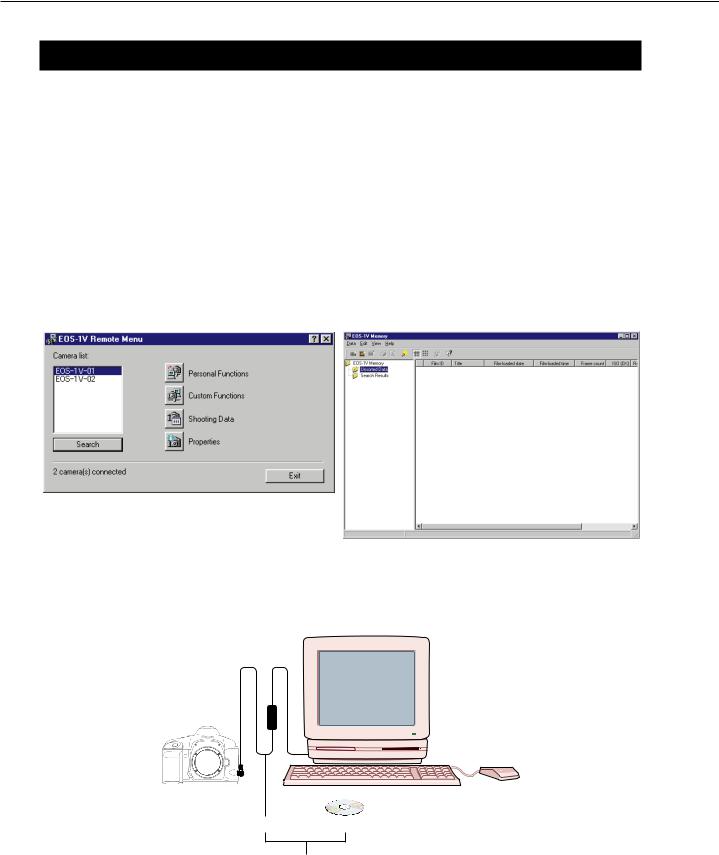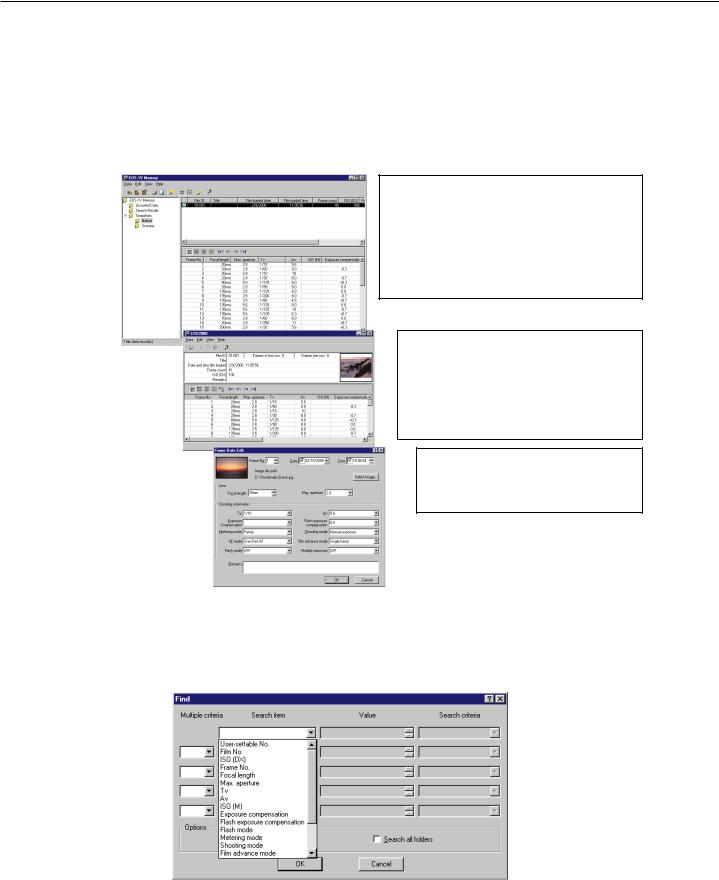CANON EOS-1V User Manual

Part 1
Product
Overview

Part 1: Product Overview
1. OVERVIEW
1.1 PRODUCT OVERVIEW
The EOS LINK SOFTWARE ES-E1 consists of the following two software programs compatible with Windows 98 (Japanese or English version indicated by J/E) and Windows 98/2000 (Japanese, English, or French version indicated by J/E/F), a connecting cable, and a USB driver for the connecting cable.
The instruction manual (in electronic form) and installation manual are provided in Japanese and English (J/E) or Japanese, English, French, German, and Spanish (J/E/F).
1) Two application programs
qEOS-1V Remote (Fig. 1-1) enables EOS-1V customization, shooting data downloading, and other functions.
w EOS-1V Memory (Fig. 1-2) enables the shooting data to be viewed and managed.
Fig. 1-1 EOS-1V Remote menu. |
Fig. 1-2 EOS-1V Memory main window. |
2) Dedicated connecting cable
The cable connects the EOS-1V's remote control/data transfer terminal to the computer's USB port.
EOS-1V
Connecting cable CD-ROM
EOS Link Software ES-E1
Fig. 1-3 System configuration.
1-1

Part 1: Product Overview
1.2 SOFTWARE OVERVIEW
1) EOS-1V Remote
This program is used for EOS-1V customization, shooting data downloading, selecting the shooting data items to be recorded, setting the film ID, setting the date and time, and other functions.
(1) Customizable functions
Thirty-one P.Fn (Personal Functions) can be set (see Table 1-1). The settings and descriptions are displayed on-screen (Fig. 1-4). The help menu also explains the effects of the Personal Functions. (P.Fn-0 is set with a Custom Function.) The Personal Function settings can be saved in the personal computer and read by the camera later. The Combination dialog box (Fig. 1-5) lists the descriptions of Personal Function settings. (This is also possible for Custom Function settings.)
The Personal Functions set with the EOS Link Software ES-E1 can be enabled or disabled with the EOS-1V individually. However, the P.Fn setting itself cannot be changed with the EOS-1V.
|
Table 1-1 List of Personal Functions |
|
|
P.Fn No. |
Function |
0 |
Registers custom function groups. |
1 |
Disables unwanted picture-taking mode(s). |
2 |
Disables unwanted metering mode(s). |
3 |
Specifies the metering mode for manual exposure. |
4 |
Sets the maximum and minimum shutter speeds to be used. |
5 |
Sets the maximum and minimum apertures to be used. |
6 |
Registers and switches the picture-taking mode and metering |
|
mode. |
7 |
Repeats AEB during continuous shooting. |
8 |
Sets AEB only for the first two frames. |
9 |
Changes the AEB sequence for C.Fn-9-2/3 to overexposure, cor- |
|
rect exposure, and underexposure. |
10 |
Retains the program shift amount. |
11 |
Prevents cancellation of multiple exposures. |
12 |
Sets the AI Servo AF's subject-tracking sensitivity. |
13 |
AI Servo AF continuous shooting is executed according to the film |
|
advance speed. |
14 |
Disables AF lens driving for focus search. |
15 |
Disables the AF-assist beam from being emitted. |
16 |
Enables the picture to be taken automatically when focus is |
|
achieved at the fixed point of focus while the shutter button is |
|
pressed completely. |
17 |
Disables automatic focusing point selection. |
18 |
Enables automatic focusing point selection when C.Fn-11-2 has |
|
been set. |
19 |
Sets the shooting speed of the various film advance modes for |
|
when the Power Drive Booster is attached. |
20 |
Limits the number of frames exposed during continuous shooting. |
21 |
Enables silent (low-speed) film rewind when the shutter button is |
|
OFF after picture-taking. |
22 |
Disables the shutter release when film has not been loaded. |
23 |
Changes the function activation timer after the button is pressed to |
|
a different time length (6 sec., 16 sec., etc.). |
24 |
Keeps the LCD panel illuminated during bulb exposures. |
25 |
Changes the default settings for when the CLEAR button is ON. |
26 |
Shortens the shutter release time lag. |
27 |
Reverses the rotational function of the electronic dial. |
28 |
Prevents exposure compensation with the Quick Control Dial. |
29 |
Issues a warning when there is enough memory to store shooting |
|
data for only a few more rolls of film. |
30 |
Changes the imprinting density of the film ID. |
Fig. 1-4 Personal Function setting dialog box.
Fig. 1-5 Combination dialog box.
1-2

Part 1: Product Overview
(2) Custom Functions
Excluding C.Fn-0, you can set 19 Custom Functions. P.Fn-0 is set with the Custom Functiondialog box.
*To prevent its accidental setting which will result in exposure error, EOS Link Software ES-E1 excludes C.Fn-0 from being user-settable.
Fig. 1-6 Custom Function dialog box.
(3) Shooting data
The Data Handling dialog box (Fig. 1-7) provides options to download the EOS-1V's shooting data to the computer, delete the shooting data in the EOS-1V, or to start up EOS-1V Memory after the shooting data is downloaded. It also indicates the number of film rolls whose shooting data is stored in the EOS-1V.
The Shooting Data Items to be Recorded dialog box (Fig. 1-8) shows the shooting data items recorded by the camera and the number of film rolls recorded. Table 1-2- 2 shows the shooting data items that can be recorded. The user can select which shooting data items are to be recorded by the camera. (This can also be done while film is in the camera.) The number of film rolls whose shooting data can be recorded by the camera will vary depending on the number of shooting data items that are recorded.
Fig. 1-7 Data Handling dialog box. |
Fig. 1-8 Shooting Data Items to be Recorded dialog |
|
box. |
1-3

Part 1: Product Overview
Table 1-2-1 Items recorded by default.
1.User-settable No. (1)
2.Film ID No. (2)
3.Film-loaded date (6)
4.DX-coded film speed (1)
5.Frame No. (1)
6.Picture-taking mode (1)
7Multiple exposures (1)
Table 1-2 Shooting Data Items
Table 1-2-2 Optional items that can be recorded.
1.Focal length (2)
2.Lens max. aperture (1)
3.Shutter speed (1)
4.Aperture (1)
5.Manually-set ISO speed (1)
6.Exposure compensation amount (1)
7.Flash exposure compensation amount (1)
8.Flash mode (1)
9.Metering mode (1)
10.Film advance mode (1)
11.AF mode (1)
12.Bulb exposure time (2)
13.Date (3)
14.Time (3)
15.Custom Function settings (11)
16.Focusing point selection (1)
17.Focusing points achieving focus (7)
18.Battery-loaded date and time (6)
Table 1-3 Correlation between recordable film rolls and bytes recorded.
Total Bytes |
Recordable Film |
|
Recorded |
Rolls |
|
0 |
~ 4 |
200 |
5 ~ 12 |
100 |
|
13 |
~ 28 |
52 |
The number of bytes required is in parentheses.
*The shaded items in Table 1- 2-2 are initially set to be recorded.
*The total number of bytes required by all the items in Table 1-2-2 is 28.
*The total bytes do not include the 12 bytes required by the items in Table 1-2-1.
(4) Properties
The Information dialog box (Fig. 1-9) shows the model name of the EOS-1V currently connected to the computer. If the camera does not contain film, you can enter the user-settable No. and apply it to the camera.
The Date and Time dialog box (Fig. 1-10) is for setting the EOS-1V's date and time. You can either apply the computer's date and time to the camera or enter the date and time manually.
|
|
|
|
Fig. 1-9 Information dialog box. |
Fig. 1-10 Date and Time dialog box. |
||
1-4

Part 1: Product Overview
2) EOS-1V Memory
EOS-1V Memory enables you to view, edit, and search the shooting data downloaded with EOS-1V Remote. You can also add thumbnail images to the shooting data by using a scanner to input the images. The shooting data can also be exported in CSV (Comma-Separated Values) format (text only) to applications such as Microsoft Excel which support the CSV format. EOS-1V Remote can also start up within EOS-1V Memory to download the shooting data.
EOS-1V Memory's main screens and their functions are shown below in Fig. 1-11.
Main window
Film data-editing window
Frame data-editing dialog box
Displayed when EOS-1V Memory starts up.
●View shooting data.
●Create and delete folders.
●Organize shooting data into folders.
●Search for shooting data (Fig. 1-12).
●Create or delete film data.
●Export the shooting data.
●Print the shooting data.
Opens from within the main window.
●Edit the film data.
●Create, delete, or update the thumbnails.
●Cut, copy, paste, or delete frame data. Insert new or copied frame data.
Opens from within the main window or film data-editing window.
●Edit the frame data.
●Create thumbnails.
*If it can be resized, it is called a window. If it cannot be resized, it is called a dialog
box.
Fig. 1-11 EOS-1V Memory main screens and functions.
Fig. 1-12 Shooting data search box.
1-5
